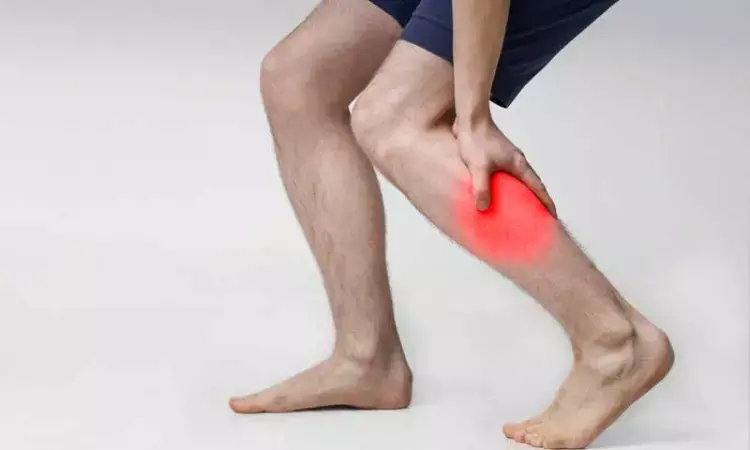- Home
- Medical news & Guidelines
- Anesthesiology
- Cardiology and CTVS
- Critical Care
- Dentistry
- Dermatology
- Diabetes and Endocrinology
- ENT
- Gastroenterology
- Medicine
- Nephrology
- Neurology
- Obstretics-Gynaecology
- Oncology
- Ophthalmology
- Orthopaedics
- Pediatrics-Neonatology
- Psychiatry
- Pulmonology
- Radiology
- Surgery
- Urology
- Laboratory Medicine
- Diet
- Nursing
- Paramedical
- Physiotherapy
- Health news
- Fact Check
- Bone Health Fact Check
- Brain Health Fact Check
- Cancer Related Fact Check
- Child Care Fact Check
- Dental and oral health fact check
- Diabetes and metabolic health fact check
- Diet and Nutrition Fact Check
- Eye and ENT Care Fact Check
- Fitness fact check
- Gut health fact check
- Heart health fact check
- Kidney health fact check
- Medical education fact check
- Men's health fact check
- Respiratory fact check
- Skin and hair care fact check
- Vaccine and Immunization fact check
- Women's health fact check
- AYUSH
- State News
- Andaman and Nicobar Islands
- Andhra Pradesh
- Arunachal Pradesh
- Assam
- Bihar
- Chandigarh
- Chattisgarh
- Dadra and Nagar Haveli
- Daman and Diu
- Delhi
- Goa
- Gujarat
- Haryana
- Himachal Pradesh
- Jammu & Kashmir
- Jharkhand
- Karnataka
- Kerala
- Ladakh
- Lakshadweep
- Madhya Pradesh
- Maharashtra
- Manipur
- Meghalaya
- Mizoram
- Nagaland
- Odisha
- Puducherry
- Punjab
- Rajasthan
- Sikkim
- Tamil Nadu
- Telangana
- Tripura
- Uttar Pradesh
- Uttrakhand
- West Bengal
- Medical Education
- Industry
Needle-based gastrocnemius lengthening: Novel ultrasound-guided non invasive technique

Isolated gastrocnemius contracture has been associated with more than 30 lower limb disorders, including plantar heel pain/plantar fasciitis, Achilles tendinosis, equinus foot, adult flatfoot, and metatarsalgia. Although many techniques are available for gastrocnemius recession, potential anesthetic, cosmetic, and wound related complications can lead to patient dissatisfaction. Open and endoscopic recession techniques usually require epidural or general anesthesia, exsanguination of the lower extremities and stitches and can damage the sural nerve, which is not under the complete control of the surgeon at all stages of the procedure.
Iborra et al conducted a study to evaluate the clinical results of a surgical technique for gastrocnemius lengthening with a needle, as previously described in cadaver specimens. This has been published in “Journal of Orthopaedic Surgery and Research.”
The authors performed a prospective study of ultrasound-guided gastrocnemius tendon lengthening in level II using a needle in 24 cases (19 patients) of gastrocnemius contracture. The study population comprised 12 males and 7 females. Mean age was 41 years (18–64). All but 5 recessions were bilateral and occurred simultaneously. The indication for the procedure was gastrocnemius contracture; although the patients also presented other conditions such as non-insertional Achilles tendinopathy in 6 patients (2 were bilateral), insertional Achilles calcifying enthesitis in 4 (1 was bilateral), metatarsalgia in 4, flexible fat foot in 1 and plantar fasciitis in 5 (2 were bilateral). The inclusion criteria were the failure of a previous conservative protocol, that the Silfverskiöld test was positive, and that the pathology suffered by the patient was within the indications for surgical lengthening of the patients and were described in the scientific literature. The exclusion criteria were that the inclusion criteria were not met, and patients with surgical risk ASA 3 or more and children. In these patients, although possible, it is preferable to perform the procedure in the operating room with monitoring, as well as in children since they could be agitated during the procedure at the office. The authors used the beveled tip of an Abbocath needle as a surgical scalpel. All patients underwent recession of the gastrocnemius tendon, as in an incomplete Strayer release. The authors evaluated pre- and post operative dorsiflexion, outcomes, and procedural pain (based on a visual analog scale and the American Orthopedic Foot and Ankle Society scores), as well as potential complications. No damage was done to the sural bundle.
Key findings of the study were:
• Ankle dorsiflexion increased on average by 17.89°.
• The average postoperative visual analog score for pain before surgery was 5.78, 5.53 in the first week, 1.89 at 1 month, and 0.26 at 3 months, decreasing to 0.11 at 9 months.
• The mean postoperative American Orthopedic Foot and Ankle Society Ankle-Hindfoot score the average was 50.52 before surgery, 43.42 at 1 week, 72.37 at 1 month, 87.37 at 3 months, and 90.79 at 9 months.
The authors concluded – “Ultrasound-guided needle lengthening of the gastrocnemius tendon is a novel, safe, and effective technique that enables the surgeon to check all the structures clearly, thus minimizing the risk of neurovascular damage. The results are encouraging, and the advantages of this approach include absence of a wound and no need for stitches. Recovery is fast and relatively painless. A specific advantage of ultrasound-guided needle lengthening of the gastrocnemius tendon is the fact that it can be performed in a specialist’s office, with a very basic instrument set and local anesthesia, thus reducing expenses.”
Further reading:
Needle-based gastrocnemius lengthening: a novel ultrasound-guided noninvasive technique: part II—clinical results Iborra et al. Journal of Orthopaedic Surgery and Research (2024) 19:203 https://doi.org/10.1186/s13018-024-04685-0
MBBS, Dip. Ortho, DNB ortho, MNAMS
Dr Supreeth D R (MBBS, Dip. Ortho, DNB ortho, MNAMS) is a practicing orthopedician with interest in medical research and publishing articles. He completed MBBS from mysore medical college, dip ortho from Trivandrum medical college and sec. DNB from Manipal Hospital, Bengaluru. He has expirence of 7years in the field of orthopedics. He has presented scientific papers & posters in various state, national and international conferences. His interest in writing articles lead the way to join medical dialogues. He can be contacted at editorial@medicaldialogues.in.


